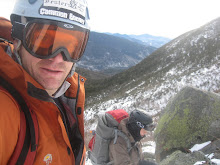 So clearly I'm putting alot of faith in Stuart McGill's expertise. Of course, I'm also putting alot of faith in my ability to understand what he teaches and then use it intelligently to make this the last time I have to "rehab" my back. This is probably simple hubris, though, because the book itself is written to help the working clinical professional and my plan is to simply go it alone. I finished "Low Back Disorders" and I'm ready to get cracking on working out again as long I'm not risking another tweaked back. First though, there are a two simple tests that I think are instructive.
So clearly I'm putting alot of faith in Stuart McGill's expertise. Of course, I'm also putting alot of faith in my ability to understand what he teaches and then use it intelligently to make this the last time I have to "rehab" my back. This is probably simple hubris, though, because the book itself is written to help the working clinical professional and my plan is to simply go it alone. I finished "Low Back Disorders" and I'm ready to get cracking on working out again as long I'm not risking another tweaked back. First though, there are a two simple tests that I think are instructive.Back Bridge Test
The first can indicate whether a person is correctly activating the glutes for hip opening. This back-bridge test is performed lying flat on your back, legs bent, knees flat on the floor. Tense your entire "core" muscles to maintain a nuetral spine as you open raise your hips off the floor, opening your hip (it's kind of like what they are showing here, but don't extend the one leg at the knee). Use your hands to feel (the fancy word is "palpate", but just start poking and prodding) which of your muscles are most strongly activated. Feel your abs (not just the six pack but all around your abdomen), then check your glutes, check your hamstrings, and check your quads. Which are working the hardest? Can you feel them working? I
Go ahead, do it now. Once you know what it's supposed to feel like you'll never do it the same again.
Your glutes should be most strongly activated. The hamstrings should be only slightly activated However, in people who have had lower back injuries, it's very common to have the hamstrings and the extensors in the lower back take much of the effort rather than glutes. This places much more of a compressive load on the spine. If you pretend to squeeze a coin between your butt and activate your quads slightly, you can feel how the glutes and hips can take the load, and this is how the body is supposed to function. Retraining hip opening to emphasize the glutes will be key.
Abdominal Muscular Enduance (aka my Spinal Fran)
OK, so now to the good measurable stuff, testing muscular endurance. Given that endurance in the 'core' musculature is protective of the spine, defining any defficiencies in this area will help guide the rehabilitation program. It will also provide a useful measuring stick of progress. This will be my "Spinal Fran" benchmark. There are three static hold tests and by comparing the length (in seconds) of static holds in these different positions, one can determine what underlying defficiencies are limiting long-term recovery in low back pain patients. So, I put together a crude test lab in my living room (see picture) and, after a trial run to get everything right, here's what I got on my second tests
Left Side Bridge = 61 seconds
Right Side Bridge = 75 seconds
55 Degree Flexion = 153 seconds
Back Extension = 138 seconds
To interpret the results, he notes that the following ratios are statistically significant in populations with low back pain. I believe these values also have some use as predictors of future back pain.
55 degree flexion/back extension >1.0 -->My value is 1.11
Right Side Bridge/Left Side Bridge outside the range 0.95 to 1.05 --> My value is 1.23
Right Side Bridge/back extension > 0.75 --> My value is 0.54
Left Side Bridge/back extension > 0.75 --> My value is 0.44
So, if I've done these correctly, this indicates that my flexion/extension ratio is aberrant (>1.0), indicating that my back extension endurance is low. I'll be working these with Bird Dogs.
It also shows that the right side lateral abs have statistically higher endurance than my left (RSB/LSB outside the range 0.95 to 1.05). I'll be working both sides with Side Bridges.
Finally, it also shows that the relative endurance of my lateral abs to my extensors is OK (less than 0.75).
Interesting. And it will be interesting to see how these change over the next few months.

No comments:
Post a Comment